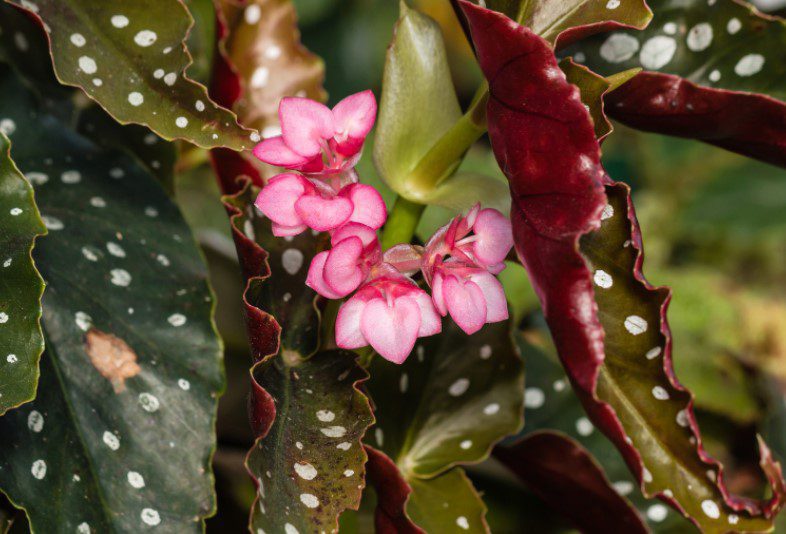Angel Wing Begonia
The shape of the angel wing begonia’s leaves is what makes it so popular. There are many varieties of these houseplants. They come in many sizes and heights. Begonia x coralline is also known as the cane begonia.
It is one of the easiest to grow indoors. An angel wing begonia is a houseplant that can be grown in most indoor environments. They can reach 5 feet (11.5 m).
Flowers
An indoor method of growing angel wings begonias will give you attractive, year-round leaves. On glossy green leaves with red backing or tints, you will see streaked or speckled foliage.
If the area is right, plants will bloom in large clusters of flowers. The happy angel wing houseplant produces large clusters of flowers in a variety of colors, including red, white, orange, pink, and pink.
The bright indirect light, air circulation, and fertilization are key to promoting flowering when grown indoors.
Care
Angel wing begonias thrive when they are surrounded by humus-rich and well-drained soil. I use approximately equal amounts of packaged, all-purpose, potting mix soil, and clean, sharp sand or perlite.
These plants are heavy and can be difficult to transport so it is a good idea to choose a larger container.
– Water requirements are always variable and depend on many factors. In spring and summer, however, it is best to water your plants as soon as you feel that the soil is “nearly dry” (or “barely moist) on the surface.
These begonias should not be left in standing water for more than 30 minutes. Wait until the soil has dried completely before watering angel-wing begonias during the shorter, cooler days of winter and fall. Some older leaves may fall off in this dry period.
– Fertilize beginning in late winter. They are able to thrive on the fish emulsion, but they also respond well to very dilute quantities of chemical fertilizers.
You can alternate between a balanced fertilizer such as 20-20-20 or a flower booster like a 15-30-15. Avoid fertilizing in the fall and early winter.
Repotting your plants at least once per year is the final step towards success. This should be done in late winter/early spring. Reduce the height of the canes that are older than the rest and any that are weaker to just a few inches above the soil.
This will encourage new, strong basal shoots. You can use the strongest parts to make tip cuttings. These will be able to take root in almost any rooting medium, such as perlite or peat moss.
Angel-wing begonias are not only beautiful, but they also have one of the strongest features: the usual bugs leave them alone. However, the brown scale and powdery mildew can pose a danger so be careful.
If you find it, take it off by hand using a cotton swab that has been dipped into rubbing alcohol. Repeat the process every five days if necessary.
WHY ARE THE LEAF TIPS OF ANGEL-WING BEGONIA TURNING BROWN
Brown drying tips on angel-wing begonias can be caused by excessive moisture, dryness, direct sun and fertilizer, and low humidity.
On the other hand, Angel-wings are hardy plants that can recover and thrive once a proper culture is restored.
However, expect a relatively slow recovery during the winter months.
Angel wings require bright light all year but no direct sunlight in the summer. A few hours of early morning or late afternoon sun are acceptable in the winter.
Angel wings can survive in temperatures that are comfortable for you. Keep them away from air conditioning and heating vents.
Because they dislike the drafts and lower humidity levels found in these areas.
Maintain the soil evenly moist from spring to autumn, allowing the surface to dry to the touch in between waterings.
After watering, empty the saucer as soon as possible; failure to do so results in soggy conditions and may cause rot.
In the winter, use water sparingly. When angel-wing foliage is thirsty, it droops slightly.
Fertilize from spring to summer, when active leaf growth is occurring. When the stems become bare and lean, don’t be afraid to prune them hard.
The best time is early spring, just before the flowers bloom.
Angel Wing Begonia Information
Scientific name: Begonia hybrid.
Growth habit: An upright evergreen perennial with light to deep green leaves often spotted or blotched with white to red markings; canelike shoots grow to 4 feet tall.
Light: Shade to filtered light.
Water needs: Prefers moist soil. Water in-ground plantings every 3 to 4 days and container plants whenever the surface soil begins to dry.
Feedings: Apply a general garden fertilizer to in-ground plantings monthly; feed container plantings every other week during periods of active growth.
Propagation: From cuttings.
Ease of culture: Easy.
Hardiness: Tender; protect from frosts and freezes.
Major problems: Avoid root rot problems by growing plants in well-drained soil and waiting until the surface soil dries before watering during the cooler months. May also be affected by mealybugs; control with a soap spray as needed.
Pruning: Taller plants need periodic trimming to encourage new stems. Give general grooming each spring to remove weak canes and errant shots. Also, remove faded flower heads as needed to keep the plants attractive.
Use: Grow as an accent plant for the tropical look in containers with pebble trays or in-ground planting for the outdoor shady spots. All have attractive foliage, and most produce clusters of white, pink, or reddish blooms like the variety Torch (above). All can be grown as houseplants in bright locations but out of the direct sun.
Florida native: No; most canelike hybrids have parentage from Brazil.


























